Help and Hope for Syrian Refugees: The Many Ways We Take Action in a Crisis
August 15, 2016
The scale of the Syrian crisis is nearly beyond comprehension: 4.9 million refugees, 6.6 million people displaced inside Syria’s borders. But the numbers don’t tell the whole story. What is it like to be on the ground? How do you help when systems are overwhelmed and communication is difficult, if not impossible? How can you make a difference?
CDC’s Emergency Response and Recovery Branch (ERRB) has been on the scene since 2012, working to protect the health of those affected by the crisis. We have conducted more than 85 humanitarian public health missions related to the crisis, making this our second largest humanitarian response to date, surpassed only by ERRB’s work following the 2010 Haiti earthquake.
In the middle of the chaos, we are there to help. We gather information, track disease, immunize people, provide nutritional counseling, train workers, and strengthen systems. We partner. We teach. We learn.
The challenges are many, and the problem is growing. Globally, one in every 113 people is now either a refugee, an asylum-seeker, or an internally displaced person (IDP). Fifty-one percent of them are children. But we’re out there every day – sometimes only a few miles from the conflict. We’re working closely with others in the region to look at issues and solve them, even as the situation shifts from moment to moment.
These are our stories.
Timeline of Select Events
March-May 2011
- The Syrian crisis begins.
- Camps for refugees open in Turkey.
July-August 2012
- Za’atari refugee camp opens in Jordan.
- CDC works with international partners during an initial assessment mission to Jordan.
September 2012
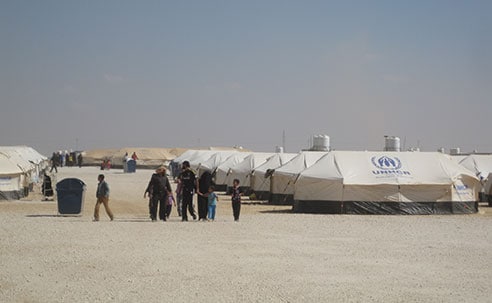
“The first time I set foot in the Za’atari refugee camp in Jordan, in Fall 2012, I couldn’t have imagined how much the crisis would grow. At the time, the camp hosted about 25,000 Syrian refugees – today, that number has more than tripled. It’s easy for diseases to spread quickly in situations like this, so the camp asked us to help set up a system to catch and report outbreaks early. Shortly after that, we helped set up an Early Warning Alert and Response Network (EWARN) to track priority diseases in northern Syria. It was a difficult time — there was no information coming from opposition-controlled areas, and no UN agency could go in. We had to set up the EWARN system from Turkey. This is the same system that later reported a polio outbreak in Syria, enabling us to act quickly to start vaccinating and stop the spread.”
Farah HusainKey Events
- CDC travels to Za’atari refugee camp in Jordan to make recommendations to UNHCR for a surveillance, outbreak alert, and response system.
December 2012
- The number of refugees in countries neighboring Syria reaches 500,000.
March 2013
- CDC conducts a 5-day training course in Jordan for more than 50 health professionals representing all the countries affected by the Syrian crisis.
- CDC and its partners evaluate emergency reproductive healthcare services for Syrian refugees in Za’atari camp and urban refugees in Irbid, Jordan.
- CDC evaluates existing mental health programs among Syrian refugees in Jordan.
May 2013
- CDC, WHO, and UNHCR support a mass measles vaccination campaign in border areas of Jordan, addressing a decline in vaccination rates from 90% before the conflict to under 50% by 2013.
- CDC helps establish EWARN system in northern Syria to help workers identify diseases most likely to cause an outbreak.
- CDC sends staff to Turkey and Jordan to strengthen disease detection for priority health conditions.
June 2013
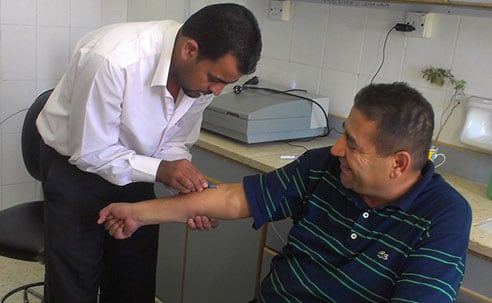
“I was in Jordan and it was snowing. Many people were living in tents. I couldn’t imagine what it must be like to live there, especially in the desert summers. We went into the city, into apartment complexes where other refugees were living. We talked to them and tried to address their concerns about tuberculosis (TB) – concerns for their families and concerns about interruptions in treatment. We realized how much the refugees really wanted someone to pay attention and help provide care for them. People were coming to Jordan because they couldn’t receive treatment at home in Syria. Some had developed multidrug-resistant tuberculosis, which is more lethal and more costly to treat than other forms of TB. This is a reality in the disruption of health services when people are forced to migrate: diseases that should be eliminated quickly can take months to treat and may end up being much worse than if treated promptly.”
Susan CooksonKey Events:
- CDC works in Jordan to increase awareness about how TB spreads and to improve the ability of healthcare professionals to diagnose and treat TB among Syrian refugees.
- CDC and partners train healthcare professionals working on Syria’s frontlines on how to collect data for EWARN and investigate outbreaks.
July 2013
- CDC sends two epidemiologists to serve as UNICEF health advisors in the Za’atari refugee camp.
- One year after opening, Za’atari camp hosts 120,000 refugees.
August 2013
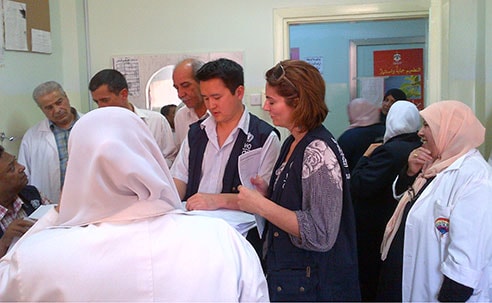
“When measles popped up in Syria, it was tough to get samples out of the country to confirm the diagnosis. Before we knew it, the outbreak had spiraled into a regional crisis. When the virus spread to surrounding countries, including Jordan, Lebanon, and Turkey, the international community planned emergency vaccination campaigns. I went to Jordan to assist in the two northern governorates that border Syria. We vaccinated both the Syrian and Jordanian communities, because around half of the refugees in Jordan don’t live in camps. We achieved over 90% coverage there, then focused on a nationwide campaign, working closely with international partners and the ministry of health to stop the spread of this contagious and deadly disease.”
Eugene LamKey Events:
- The second round of the measles vaccination campaign takes place in Jordan.
- CDC works at Za’atari camp to evaluate how data on reproductive health are being collected and shared.
- The number of Syrian refugee children exceeds 1 million.
Fall 2013
- The number of Syrian refugees passes the 2 million mark, with an additional 4.25 million IDPs.
- EWARN detects a polio outbreak in oppositioncontrolled Syria, initiating a vaccination campaign.
- CDC provides ongoing assistance with acute flaccid paralysis surveillance for polio cases.
July 2014
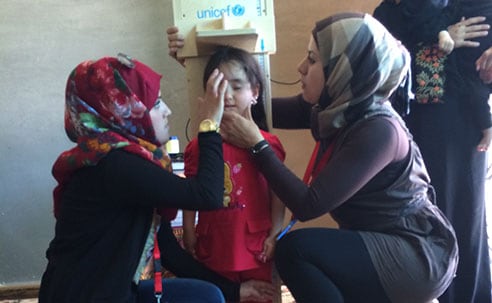
“In Za’atari, we went door to door to collect information about the nutritional status of Syrian refugees living in the camp. We know that malnutrition is often a problem among refugees; however, it’s also linked with many infectious diseases, like measles. We measured children to see how they were doing: weight, height, mid-upper arm circumference, and their hemoglobin levels. While there were few malnourished children, we found many with anemia. Together with partners, we recommended programs to make sure refugees have easy access to fortified flour and more nutritious diets. We have also worked with partners who are providing services inside Syria’s borders, where our challenges are different. We have had to provide remote support to local partners who are able to reach places we cannot go, and these partners deserve a lot of the credit. It’s dangerous work.”
Eva LeidmanKey Events
- CDC travels to Jordan to help UNICEF conduct a quality review of nutrition and health surveys of Syrian refugee and host populations.
December 2014
- CDC presents the impact of EWARN at a symposium in Gaziantep, Turkey.
July 2015
- CDC develops guidelines with partners to evaluate EWARN in response to the Syrian crisis.
October 2015
- Iraq reports an outbreak of cholera in refugee camps.
November 2015
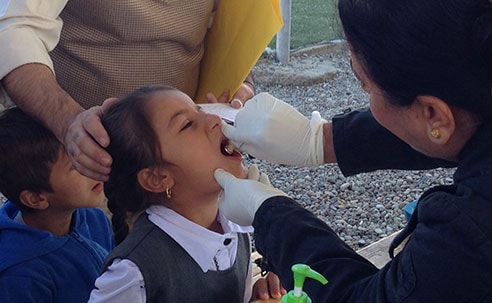
“You try not to think about it – how close you are to danger. Mosul had been taken over, and ISIS was mere hours away. Near the Iraqi city of Erbil, people in camps tried to make life as normal as possible — children going to school, trying to carry on with everyday life. I was there to help respond to an outbreak of cholera in the country. In addition to working on clean water and sanitation, the Iraq Ministry of Health and key partners were conducting a two-dose oral cholera vaccination campaign to try to prevent the outbreak from moving into Syria. After the second round of immunization, we helped conduct a coverage survey using electronic tablets to send real-time data, allowing us to make corrections immediately if needed. We found that vaccination coverage was close to 90%, despite the complexity of the situation.”
Eugene LamKey Events:
- In Iraq, CDC helps plan and conduct the first round of an oral cholera vaccination campaign, strengthens surveillance for cholera, and implements water, sanitation, and hygiene procedures.
December 2015
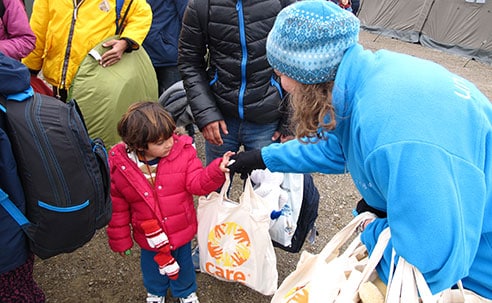
“The fog was thick at the Slavonski Brod station as refugees spilled off the train. They wouldn’t stay long — about an hour. They filed through tents, receiving basic supplies: hygiene kits, hot tea, meals, and clothing. A separate, small tent provided access to minimal healthcare along with space for infant feeding, clothing, and breastfeeding support. This is where I stood. I had 15 minutes to give a comprehensive infant feeding assessment in my 20-foot by 20-foot tent. We asked mothers if they were breastfeeding, which we encouraged. We managed a bottle exchange for mothers with dirty or broken bottles who didn’t want to breastfeed or cup-feed. To ensure safer artificial feeding, we offered ready-to-use, liquid formula instead of powdered infant formula. I was just one of many who were working to make the best of a terrible situation. All of us in that station seized every minute to help replenish, educate, and prepare these tired travelers for the next grueling leg of their journey.”
Leisel TalleyKey Events:
- CDC helps conduct the second round of the Iraq oral cholera vaccination campaign and post-campaign coverage survey.
- CDC travels to Croatia to address infant and young child feeding among migrants transiting through Europe.
January 2016
- CDC evaluates EWARN in refugee and IDP camps in Iraq.
- CDC mental health expert mentors an Emory University student to conduct a mental health survey among Syrian refugees in Atlanta.
April 2016
- CDC assists the U.S. Embassy in Greece in a rapid public health assessment of refugee sites across Greece after implementation of the European Union-Turkey agreement.
May 2016
“We had traveled halfway across the world to train people, but we were suddenly looking at the very real possibility of facing an empty classroom. Our students, a group of Syrian clinicians eager to learn more about the EWARN surveillance system, were stuck at the border. We ended up having to condense our training into just two days, but we were grateful we were finally there in person after many trainings over Skype. The Skype trainings were very inefficient; a conversation that should take 30 minutes would take two hours. Imagine what happens when you try to do a three-hour training! The clinicians wanted to take what they learned in the training and share it in their country because there are a lot of clinicians who need this information. When we asked them about the danger they might face, especially in the north, they told us, ‘We don’t care anymore. We want to do this.'”
Kristi Cordes and Colleen HardyKey Events
- CDC conducts the first ever face-to-face EWARN training for staff from southern Syria.
Present
- As the crisis expands, CDC continues to provide expertise and assistance to Syria’s refugees.